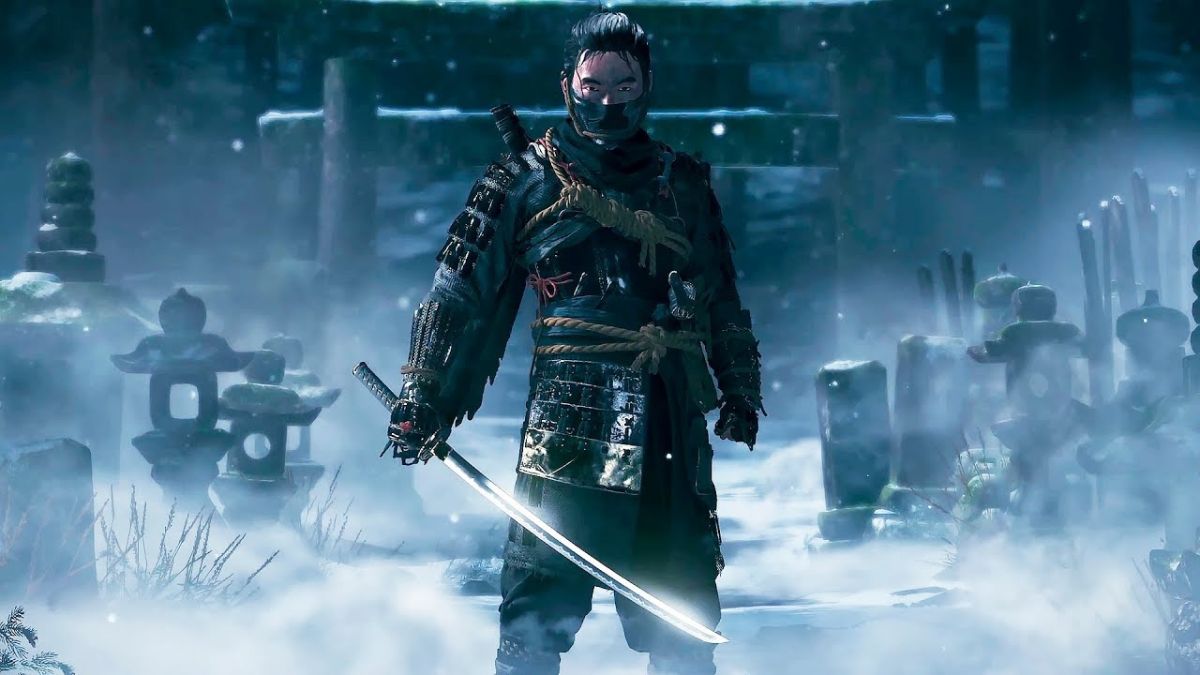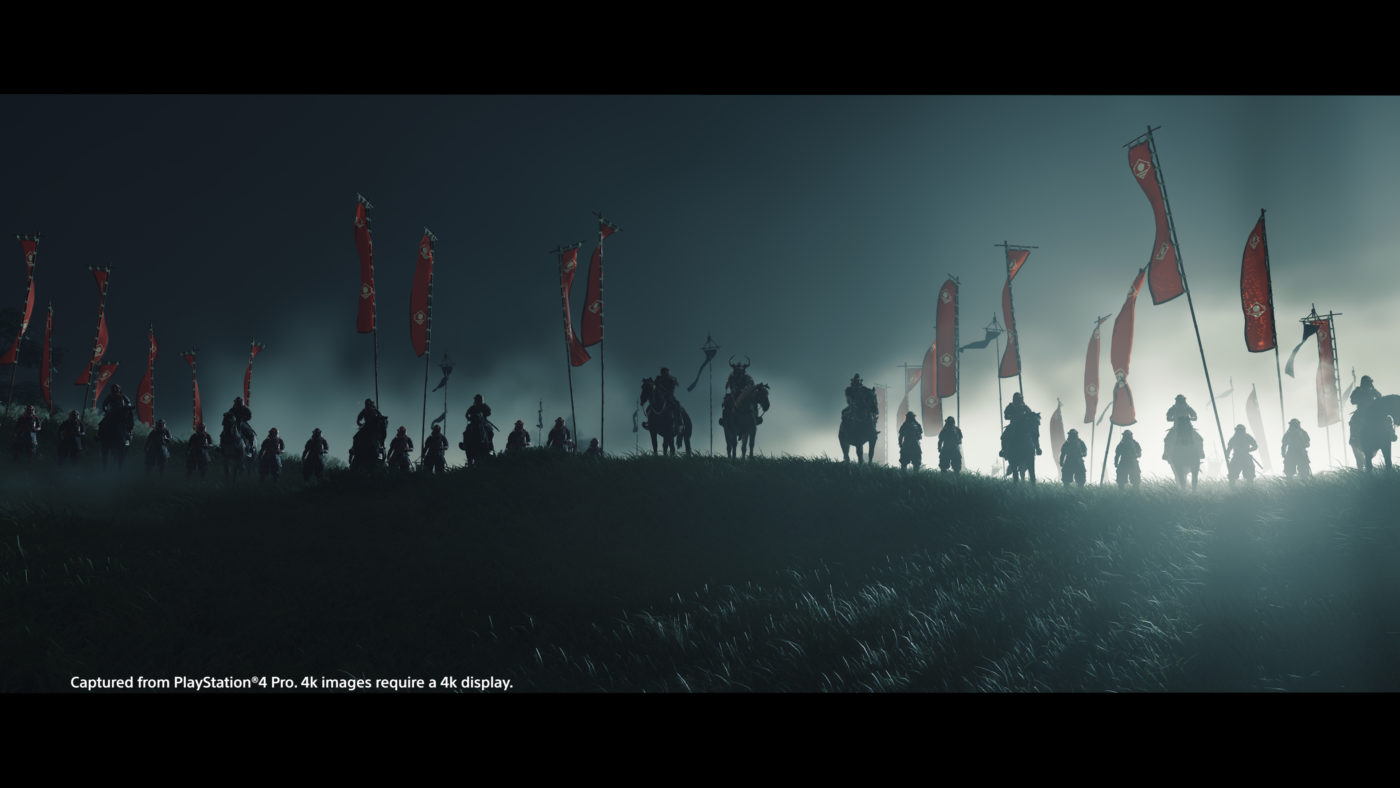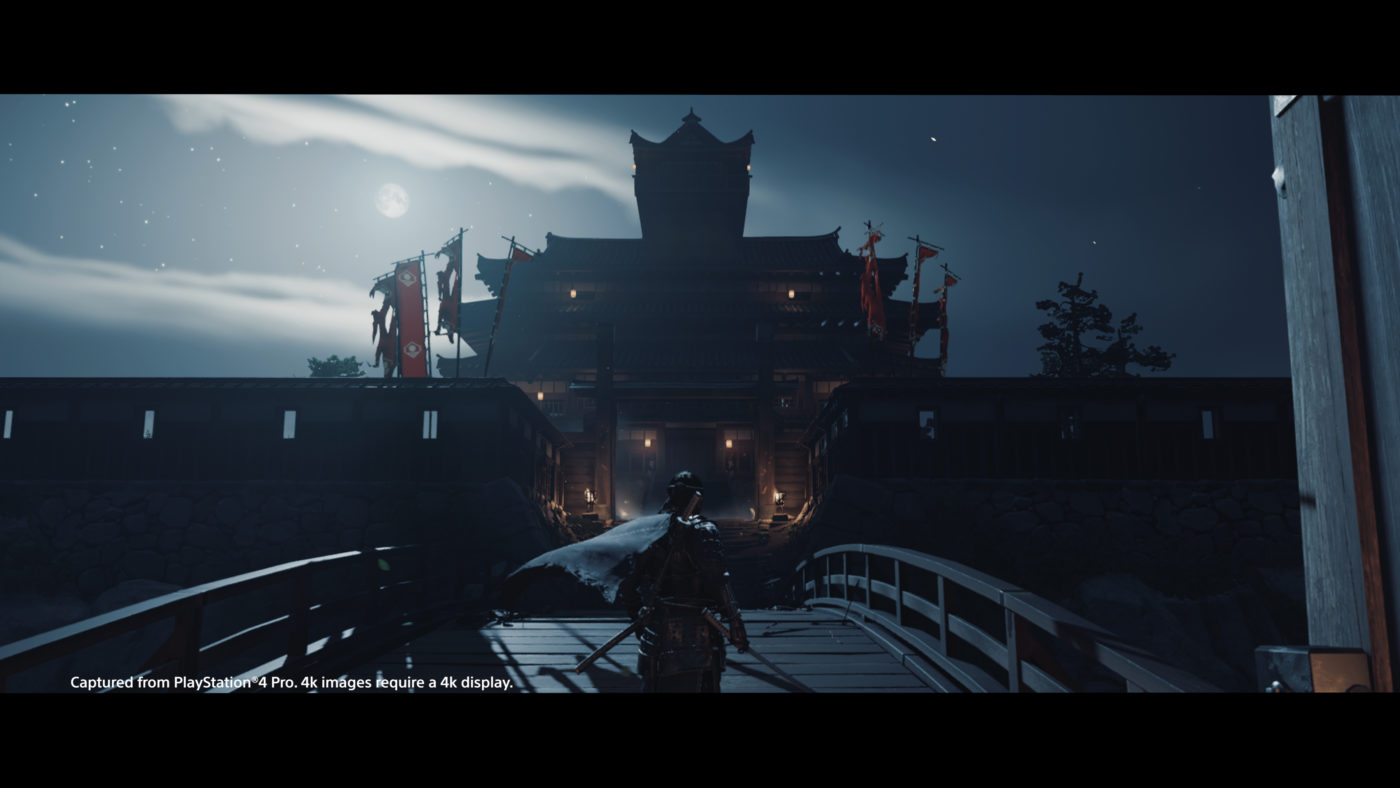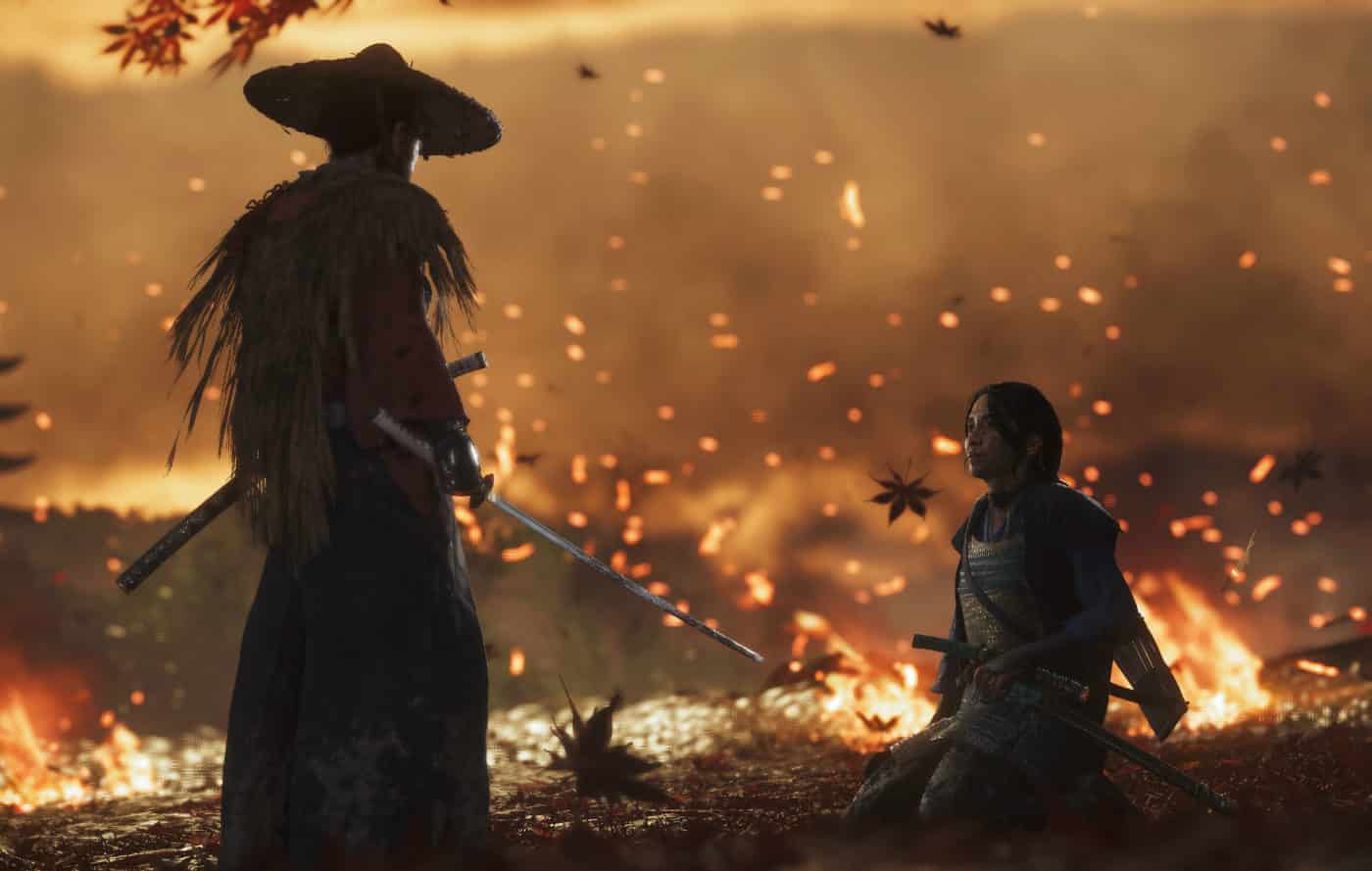It’s been about six years since Sucker Punch Productions released inFamous First Light, which was a standalone title that complemented inFamous Second Son. Now that we’re at the cusp of the nex-generation of gaming with the PS5 (and Xbox Series X), the studio has finally released its long-gestating project, Ghost of Tsushima. Does Sucker Punch deliver a cut to remember or is it a sword that’s been dulled from being in the scabbard too long? Read on for our Ghost of Tsushima review.
Note: While we will touch upon specific gameplay mechanics and the very early part of the game, we will refrain from spoiling any key beats and events, as we feel these should be experienced by players fresh. In short: this is a spoiler-free review.
Samurai in the Darkness
Right of the bat, Sucker Punch thrusts players into the war between Japan against the Mongols. We’re immediately introduced to the big baddie of the game, Khotun Khan. While this acts as the tutorial section of sorts, it also dives in to the central plot of the game, which is about the Mongols invading Tsushima. While it seems like a cut and dry story at face value, there are a lot of nuances and plot exposition that transpires as you play the main campaign, and tackle the multitude of side missions and quests the game throws at you.
Gamers will play as Jin Sakai, a renowned samurai warrior and nephew of Lord Shinkawa; the Jito of Tsushima. Not diving into spoilers even if it happens early on, Jin will soon face the realization that being a samurai, even if he’s a good one at that, won’t be enough to win the war. The story relies heavily into Japanese (and Asian) culture, and how the samurai had a different way of thinking when it comes to nobility, morality and even war. This inner struggle of seeing Jin think twice about doing something even if it means defeating your enemies is part of the journey the player will experience in Ghost of Tsushima. It adds a layer of depth to the character and humanizes him instead of seeing a one-man army that wants to face every enemy head-on.
When you start Ghost of Tsushima, Jin Sakai is your highly respected nobleman; a samurai that fights with honor, and someone who’s respected by people due to his title and nobility. Inch by inch though (or mission by mission), you’ll be tearing away at that as you build the legend of the Ghost — a fearsome demon that strikes in the shadows, and does whatever it takes to achieve his goals. There’s more to this than just building your reputation and killing off as many enemies as you can, but I’ll leave it for you to discover on your own.
Stone, Water, Wind and Moon
If you were expecting a mindless hack and slasher, you’re in for a nasty surprise. Sure, you’ll be able to survive (and even do well initally) just by mashing buttons repeatedly in the first few story missions, but once the different enemy types roll in, and you’re given quite a number to deal with all at once, you’ll need to be able to strategically take them out. The combat is fluid, easy enough for button mashers, but a treat once you master the different stances, parries, and combos. You can’t help but feel like a badass when you jump down from a roof assassinating multiple enemies at once, and then throwing a kunai (throwing dagger) at enemies, and then proceeding to slice off the rest.
What gives the swordplay depth is how stances work. Stances are earned via in-game progression, and each stance has its own skill tree, and specializes against a specific enemy type. Players will be able to switch stances on the fly depending on the enemy they’re facing, and what combos/moves they want to pull off. Changing stances is as easy as a button press, and in just a matter of encounters, will feel second nature.
However, the blade isn’t the only weapon in Jin’s arsenal. There are loads of weapons to use from aside from your trusty samurai and tanto. There are bows, darts, bombs and more. Remember Tenchu from the PS1? Yeah, Jin plays like a ninja but only a lot more badass with gadgets, and combos. He’s like the samura-era version of Batman with his silent takedowns, throwing daggers, hiding on top of roofs, etc.
What’s refreshing here is how much freedom Sucker Punch has given the player in going through the game. Sure, there are fights that you absolutely must take head-on, but for the most part, missions, side missions and whatnot, can be completed by going full stealth and assassinating everyone; going in head-on and just slashing everyone to death,or a mixture of both. I went with what I felt was right at the time. If I wanted to conserve supplies and such, I’d go full-on stealth, or once I had Jin powered up enough, I just went hog wild on enemies and it felt empowering being able to slash, parry and dance around bleeding corpses.
Not everything about the combat is perfect though. Unfortunately when multiple enemies are on-screen at once, this is where one of the game’s design flaws come into focus. In Ghost of Tsushima, there is no way to auto-lock the camera. So if you’re fighting against 5-6 enemies and there are two that near each other, you’ll sometimes struggle to hit the exact enemy you want. Not to mention, the camera sometimes will block your view of the combat as well. It seems Sucker Punch opted for a more free-flowing combat system where players can point the direction of the analog stick to where they want to attack. While I do get where Sucker Punch is coming from, an option to have a lock-on mechanic for the camera to keep your view at a certain enemy would have been much appreciated. That said, after a few hours in, you’ll get used to it and won’t bother you that much.
Speaking of enemies, the game throws different variations of Mongol warriors at you. There are ones that dual wield swords, brutes that carry big shields, ones with shields, spearmen, and more. At the latter part of the game, you’ll start enountering armored enemies that not only make it harder to slay, but you can’t cheese your way to victory by shooting them in the head with arrows. I mean, you still can, but Heavy Arrows are much scarcer in supply than regular ones. In addition to different enemy types like spearmen, brutes, etc., you’ll be going up against bandits, and other enemies as well, and won’t just be the Mongols. Thankfully, Sucker Punch has made it so that you will be able to take one look at an enemy, and be able to determine what tactic or weapon/move will be useful against them.
https://www.youtube.com/watch?v=Vt-8RG1jxzg
Strong Sides
During my playthrough of Ghost of Tsushima, one thing that immediately jumped up to me after a few hours is how similar it is to CD Projekt RED’s The Witcher 3. While it’s pretty evident that Sucker Punch was insipired by that game, Shadow of Mordor, and more, the main thing why I remembered The Witcher 3 (and even compared it to) when playing is, how both games have excellent side missions and ancillary characters.
Sure, there are the traditional “throwaway” side missions (putting that in quotes since some of these said throwaway missions are very interesting in their own right), and there are camps you need to liberate (read: kill all enemies), but the actual side missions that involve recurring characters, they’re really fleshed out, and have their own story arc that in some cases, rival those of the main story.
Sucker Punch has done a masterful job of having the game’s supporting cast feel involved enough with Jin’s adventures and fate that you will care for them after starting each one’s questline. These said side quests (and even some of the smaller ones), don’t just involve Jin going to a place and killing all the enemies. I mean, sure, that happens a lot, but there are also missions where you need to observe someone and what their plans are, avenge a fallen friend, collect certain items, and more. There’s a lot of variety in ’em, and some even yield surprising results in terms of the outcome.
What strengthens these side missions are the variety in terms of progression mechanics, and at just the sheer amount of content players can choose to dive into if they so wish. There’s your usual ranking up level tree, which gives the player free rein in what they want to learn first depending on their play style, and on top of that, there are sword kits to collect, hats, armors, charms, and more. Each collectible has their little quest to complete if you want to earn them, but they are in no way mandatory. In addition to the side quests and the main campaign, there are also what Sucker Punch calls Mythical Tales, that give Jin powerful new abilities and equipment to aid in his journey against the Mongolian horde. While the amount of stuff to collect and earn might be daunting at first, you’ll be glad to know that it’s in by no means needed, and usually, most of these objectives are on the way of another objective, which means you’ll be hitting two birds in one stone for some. Even with that though, don’t expect to clear the land of Tsushima quickly. In my playthrough, I suspect I played close to 50 hours (or more) to see everything I can in the game. Sadly, there’s no in-game timer, so I don’t know the exact play duration from start to finish. With Sucker Punch taking their sweet time releasing the game, I now understood why. After completing Tsushima, it’s easy to see why Sucker Punch took this long to develop the game, as it’s just jam-packed with content.
The Way of the Samurai
While Sucker Punch has nailed a lot of things right with Jin’s debut journey, there are some little quibbles I had with it. Namely, the AI is, in some parts, questionable; the game tends to be quite easy once you’ve leveled up and learned how to parry properly, and I’ve encountered a glitched side mission. But these issues are problems that Sucker Punch can easily patch out (I assume), and even if they didn’t, doesn’t really mar the overall experience given the whole package is top-tier material.
The amount of content and fun in Ghost of Tsushima is easily worth $60. Understandably, people will compare Ghost of Tsushima with other open-world games. Sure, the Witcher 3 and even Red Dead Redemption 2 might have more active game worlds in comparison, but that doesn’t lessen the fun you’ll experience in Tsushima, and one can argue that it offers a tigher, more focused main campaign. Possibly the biggest indicator that Sucker Punch and Sony has another hit franchise in their hands? At the end of Jin’s journey, you’ll be left wanting more — and that’s with me playing it for 50 hours!
If Ghost of Tsushima is the swan song game for the PS4, then it ends with a whirlwind of slashes, and it gives Sucker Punch the franchise it’s aiming for that stands toe to toe with the likes of God of War, Uncharted, and the rest of Sony’s impressive first-party studio games lineup.
Rejoice, samurai warriors! Ghost of Tsushima lives up to the hype and even surpasses it. This is one Ghost you’ll want to see more of soon.
Score: 9.5/10
- Super fast load times!
- Jam-packed with content from start to finish
- Story and side missions are excellent
- Jin feels like a samura-era badass Batman
- Combat is tight, and lets you play the game in your own way
Cons:
- AI issues in some encounters
- Some minor collision bugs
- You can’t skip confrontation, side quest cinematics
Ghost of Tsushima review code provided by the publisher. Reviewed on PS4. You can read SP1st and MP1st’s review and scoring policy right here. Ghost of Tsushima will be out this July 17 on the PS4.





Awesome review! I agree with all of your points. I forgot to mention the load times in my review but holy hot darn, are they ever quick! It boggles my mind how you can fast travel anywhere and don’t even need to wait.
Thanks so much! 🙂